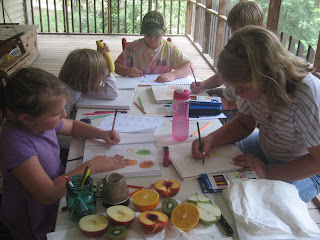There are entire books written about how to homeschool. Some are very good and helpful. There are numerous articles, blogs, websites, and support groups. But, I am going to break it down to the very first crucial steps to homeschooling. The core of successful homeschooling is that it is a lifestyle. It will take time to bring this new way of looking at the world and at education into your home. It will take time to adjust your thinking to a new paradigm. Give yourself that time. Don't worry that you must have all the answers this week or that you must decide on your child's learning style by Saturday. First and foremost, homeschooling is a journey that you take with your child. Take some time to think about what that journey will look like, what to pack, and above all, count the cost.
Homeschoolers spend a lot of time with their children. A LOT of time. Take a look at your home life. Do you enjoy spending time with your children? Are you able to instruct them and coach them through tasks? Are you able to be with them for the majority of the day, the week, the month, the year and enjoy it? This may seem like a simple question - but more than what kind of curriculum to use or which group to join, this question can make or break your homeschool experience. Don't despair if your answer is no. Are you willing to work at it? Are you willing to spend time taking an honest look at your home life and working together with your children to create an environment conducive to learning? No home is perfect, but you will all be happier if you can create an environment that includes what you and your children need to get along well with each other. This is perhaps the first and most important step to homeschooling.
When you homeschool, you are the one calling the shots. You must be able to take responsibility for creating your own program. There are many options and you can certainly use a program that lays everything out for you, a computer based curriculum, or a satellite school. But, at the end of the day, you must decide what is best for your child. This can seem overwhelming to new homeschoolers. If you are used to having a school or a teacher tell you exactly what to do and when, the new freedom can feel... well, free. Freedom is a great thing, but it can feel scary at first. Give yourself time to adjust to this brave new world. You really can do it, but you will need to put in some research time on the computer, reading books, and/or talking to other homeschoolers. You are now a teacher as well as a parent. You will need some teacher planning time, some time to invest in your own learning, and down time to rest and rejuvenate. Make sure you have a realistic expectation of the time and energy this will take on your part.
Finally, homeschooling does cost money. There are certainly ways to reduce the cost, but it is not free. For one thing, there will need to be a parent at home and guiding the homeschooling. My husband and I have always worked and homeschooled. It can be done. It is not easy. We have worked schedules that we could arrange around having a parent home and, some years, we have also had to hire a caregiver. I will not go into all the details, but you will most likely have to limit your career choices or at least one of you will. There are certainly careers that will work well with flexible schedules, but not all jobs are conducive to flexibility. Some of you may have an adult in the home that can financially support a stay at home parent. Still, that parent is loosing the option to build their career while the children are homeschooling. This is something to take into consideration when you decide to homeschool.
You will also have to purchase materials. You can limit your spending by making great use of the public library, going to used curriculum sales, shopping for used items online, and even swapping materials in your homeschool group. But, you will spend some money on curriculum, books, microscopes, instruments, sports equipment, and more books. You will also spend some money on classes, museums, field trips, and co-ops. The amount each family will spend will vary greatly, but a general rule is that if you need to cut corners on time, expect to spend a little more money.
I absolutely love homeschooling. I have homeschooled both of my children for their entire education to date. I have a high school and a middle school student and we love our homeschool life. I really believe that anyone who can look up answers and read can homeschool their children. But, you must be willing to look up answers. When I am helping new homeschoolers get started for the first time, these are the things I wish they knew. There are amazing benefits to homeschooling - you just have to be willing to put in some elbow grease.
















